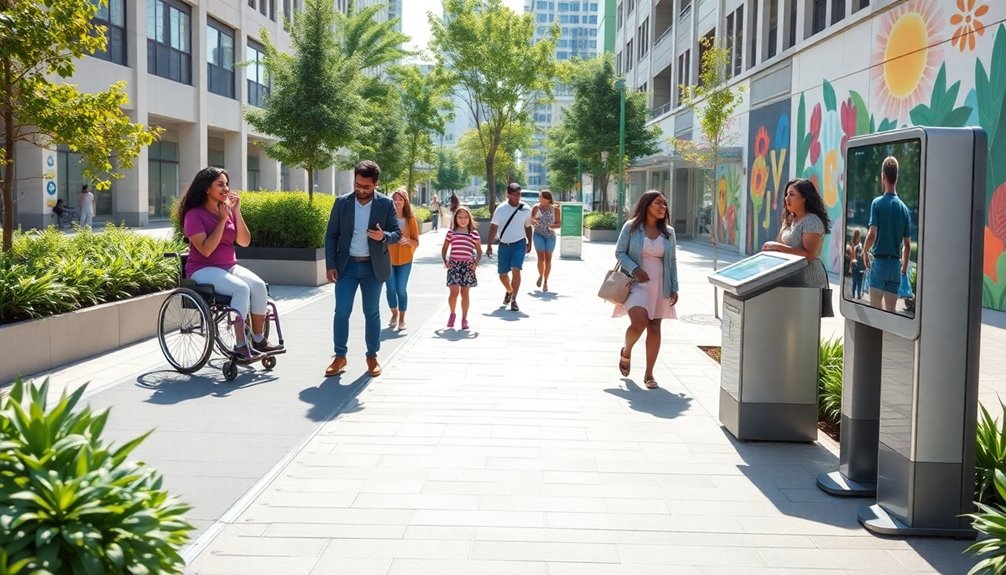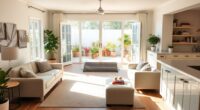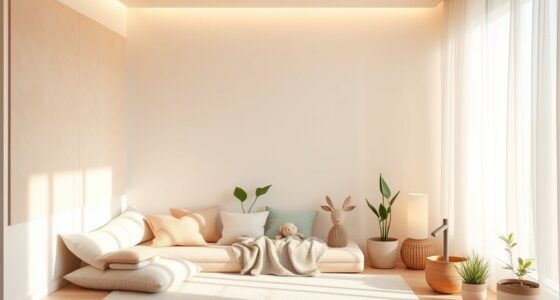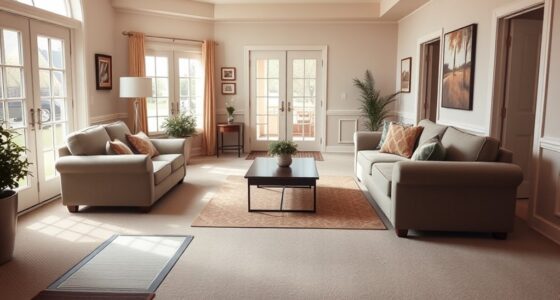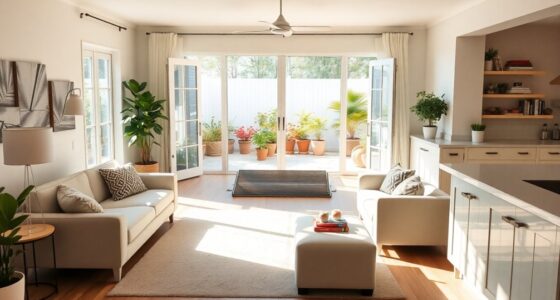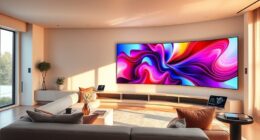Discovering game-changing innovations in accessibility and universal design transforms environments for everyone. You'll see how task lighting and rocker switches enhance usability for those with visual impairments or limited dexterity. Slip-resistant flooring guarantees safety, while access ramps and automatic doors promote seamless navigation. Grab bars and shower benches provide essential support in bathrooms. Smart devices like the Nest Thermostat and touchless hand dryers enhance convenience and hygiene. Dive deeper to uncover even more exciting solutions that elevate inclusivity!
Key Takeaways
- Smart home devices, like the Nest Thermostat, enhance accessibility through voice control and large displays for individuals with visual impairments.
- Touchless public amenities, such as hand dryers, promote hygiene while catering to users with limited hand strength through adjustable settings.
- Slip-resistant flooring materials improve safety in moisture-prone areas, significantly reducing the risk of trips and falls for all users.
- Curbless shower designs and shower benches create seamless access for wheelchair users, enhancing bathroom safety and usability for individuals with limited mobility.
- Acoustic panels improve communication and focus in various spaces by reducing distractions, benefiting neurodiverse individuals and promoting a calmer environment.
Task Lighting & Rocker Switches
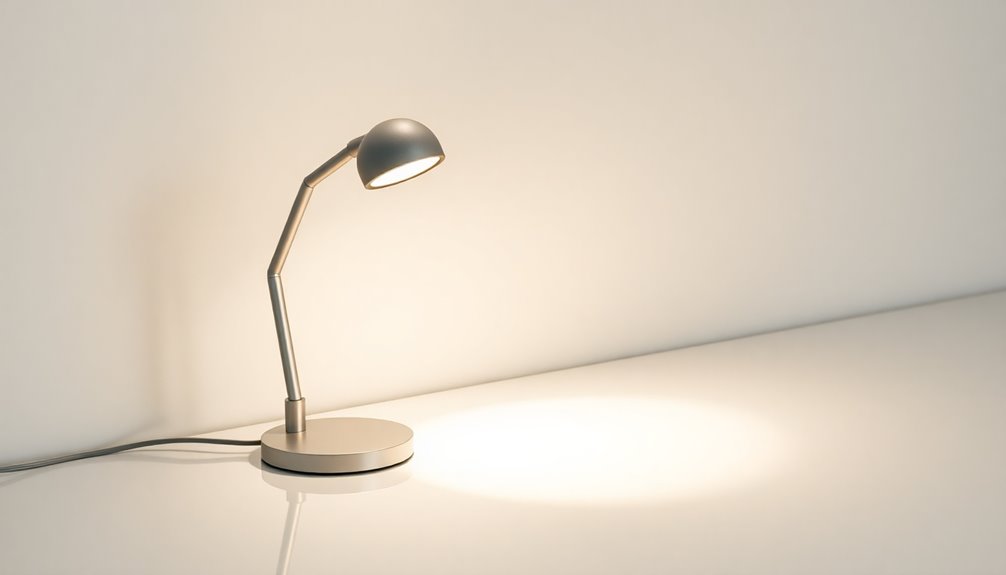
When you think about creating an accessible space, task lighting and rocker switches play essential roles in enhancing usability.
Task lighting provides focused illumination, making specific activities easier for individuals with disabilities, particularly those with visual impairments. By reducing eye strain, it enhances their ability to complete detailed tasks effectively.
On the other hand, rocker switches are a fantastic feature of accessible design. They allow users to operate lights and appliances with minimal effort, which is especially beneficial for individuals with limited dexterity.
Many modern rocker switches include tactile indicators or contrasting colors, improving usability even further. Incorporating universal design principles ensures that these features are beneficial for everyone, not just those with disabilities.
Slip-Resistant Flooring & Finishes
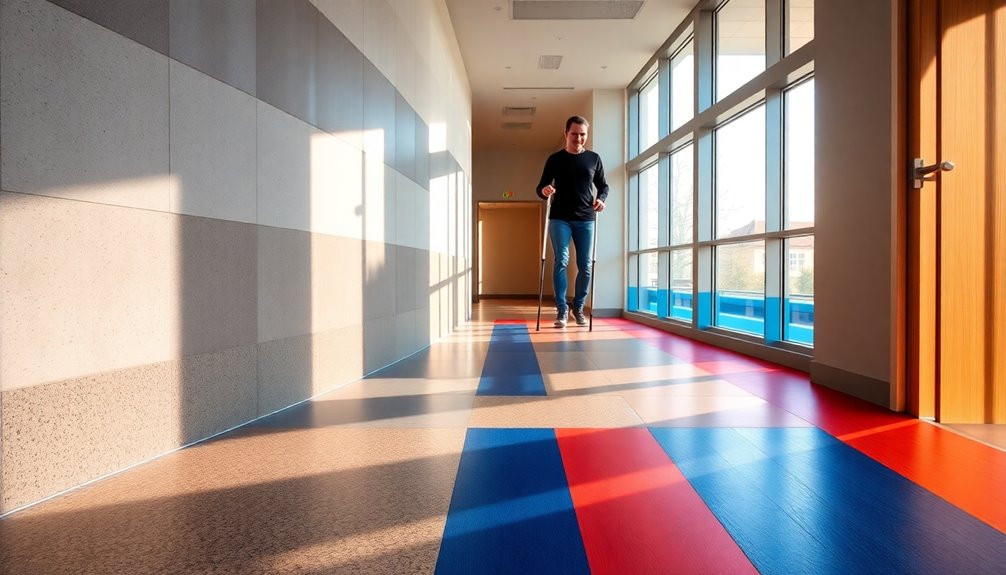
When you think about flooring options, slip resistance should be at the top of your list for safety.
Eco-friendly materials are now available that not only enhance safety features but also offer versatile design options to suit any space.
Enhanced Safety Features
Slip-resistant flooring plays an essential role in ensuring safety across various environments, especially in areas susceptible to moisture.
By integrating enhanced safety features into your design, you create a more accessible space for everyone, particularly people with disabilities.
Rubber flooring is a fantastic option due to its high coefficient of friction, offering both slip resistance and cushioning to minimize injury risks.
Textured surfaces can also boost safety, but they must be carefully designed to prevent tripping hazards.
Remember that regular maintenance is key to retaining these safety properties and complying with regulations.
Eco-Friendly Materials
Choosing eco-friendly materials for slip-resistant flooring and finishes not only enhances safety but also supports sustainable design practices.
By opting for recycled rubber, you can achieve superior accessibility and Universal Design solutions that benefit various environments, such as airports, hospitals, and schools.
Here are four key advantages of using eco-friendly slip-resistant flooring:
- High Coefficient of Friction: Rubber flooring offers exceptional slip resistance, reducing the risk of trips and falls.
- Textured Surfaces: Carefully designed textures enhance slip resistance without creating tripping hazards.
- Vibrant Aesthetics: Available in diverse colors, patterns, and textures, these materials fit seamlessly into any design aesthetic.
- Regular Maintenance: Proper upkeep guarantees ongoing compliance with safety regulations.
Additionally, utilizing eco-friendly materials fosters mindful consumption practices that contribute to a healthier environment for future generations.
Versatile Design Options
Eco-friendly materials set the stage for versatile design options in slip-resistant flooring and finishes.
By implementing effective design strategies, you can guarantee safety and accessibility for everyone, especially those using assistive technologies.
Rubber flooring, with its high coefficient of friction, is a prime choice for high-traffic areas, combining durability with comfort.
Manufacturers increasingly use recycled rubber, promoting sustainable practices in inclusive design.
Textured surfaces can enhance slip resistance but require careful planning to avoid tripping hazards.
Regular maintenance is essential to keep these surfaces safe and compliant with regulations. Air purifiers can also contribute to maintaining a healthy indoor environment, enhancing overall safety and comfort.
Embracing these innovations not only elevates your space's aesthetic but also fosters an environment that champions digital accessibility and safety for all users.
Access Ramps

Access ramps play an essential role in guaranteeing that everyone can navigate buildings and public spaces with ease.
These ramps are crucial for individuals with disabilities, providing independence and mobility.
When designing access ramps, you'll want to follow these key principles:
- Slope Ratio: Maintain a maximum slope of 1:12 to guarantee safety.
- Width: Guarantee a minimum clear width of 36 inches for easy passage.
- Handrails: Install handrails on ramps rising over 6 inches for stability.
- Level Landings: Include level landings at the top and bottom for safe changes.
Using assistive technology, such as modular ramp systems from EZ-ACCESS, can help meet ADA requirements while offering versatile solutions for various applications.
Automatic Doors & Door Operators
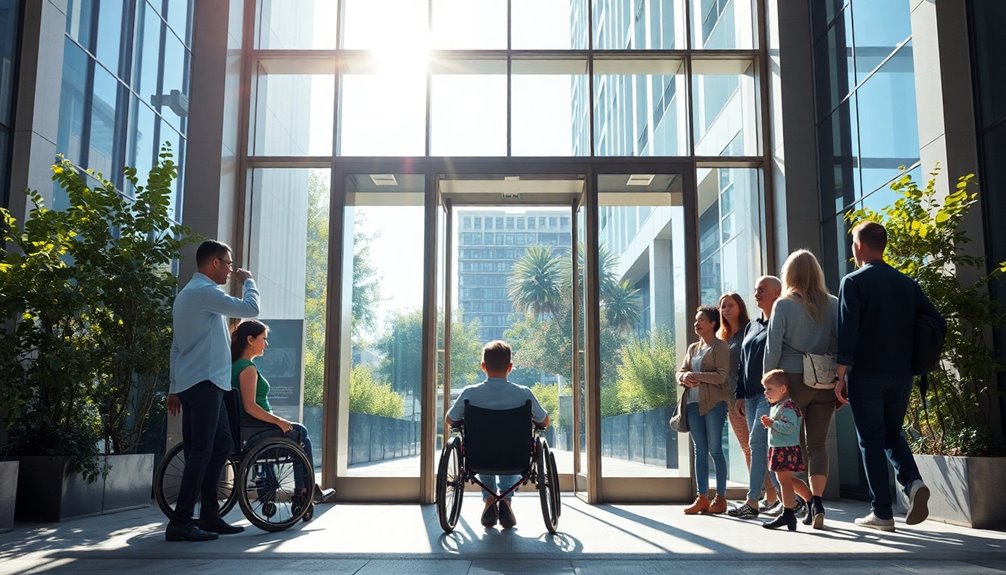
Automatic doors and door operators are essential components of universal design, making it easier for everyone to enter and exit buildings. They enhance accessibility by eliminating barriers, allowing individuals using mobility aids or carrying items to move freely.
For instance, the ADAEZ model from ASSA ABLOY retrofits existing swing doors with low-energy automatic solutions, ensuring greater access. You can also find push-button options that are wired or triggered by radio frequency, making them user-friendly for all.
Automatic sliding doors shine in public spaces, offering a seamless entry experience without exertion. By incorporating these innovations, we create a more inclusive environment that prioritizes accessibility, aligning with the philosophy that everyone deserves equal access to spaces.
Grab Bars

While many might overlook their importance, grab bars play an essential role in enhancing safety and accessibility in bathrooms and other areas prone to slips. They provide significant support for individuals with limited mobility, reducing the risk of falls.
When considering grab bars, keep these points in mind:
- Length Requirements: ADA guidelines recommend side wall grab bars to be at least 42 inches long and rear wall bars at least 36 inches.
- Design Options: Grab bars come in various finishes, like peened and satin, ensuring they fit your aesthetic.
- Secure Installation: Proper anchoring is critical for stability and safety.
- Versatility: They benefit not only the elderly but also anyone recovering from surgery or injury, promoting universal design and accessibility.
Linear Drains
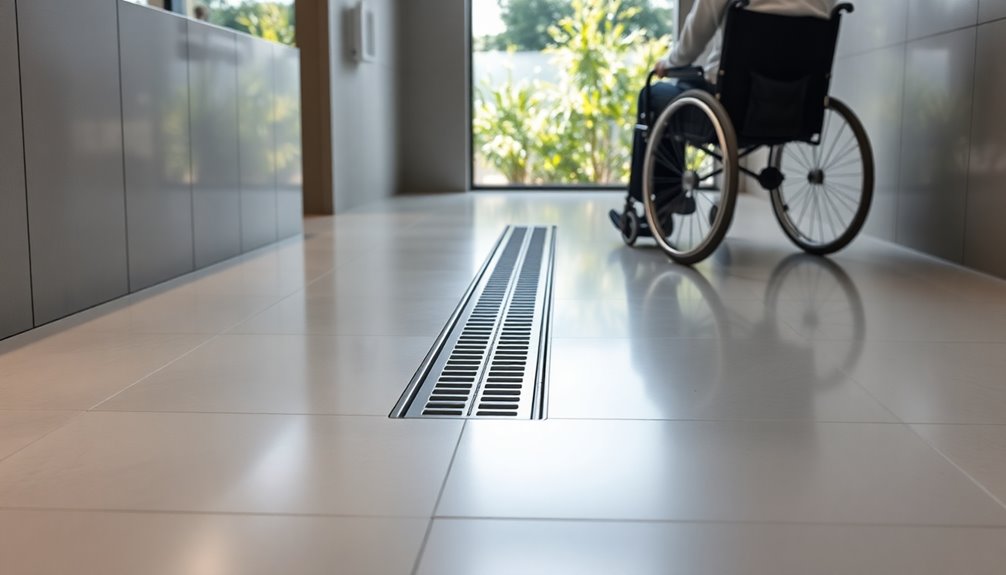
Linear drains are revolutionizing bathroom design by creating a curbless shower experience that enhances accessibility for everyone.
With systems like QuickDrain's WallDrain, you can enjoy a sleek look while promoting universal design principles. These innovative drainage solutions eliminate traditional shower curbs, making it easier for individuals using wheelchairs and mobility aids to navigate safely.
By effectively managing water flow, linear drains help prevent slips in wet conditions, ensuring safety for all users. They're especially beneficial in multigenerational households, accommodating diverse mobility requirements.
Plus, their design aligns with ADA standards, reinforcing your commitment to accessibility in your home. Embracing linear drains means prioritizing both style and functionality in your bathroom spaces. Additionally, their installation can be complemented by energy-efficient heat pumps, which provide year-round climate control and can enhance overall home accessibility.
Nest Thermostat
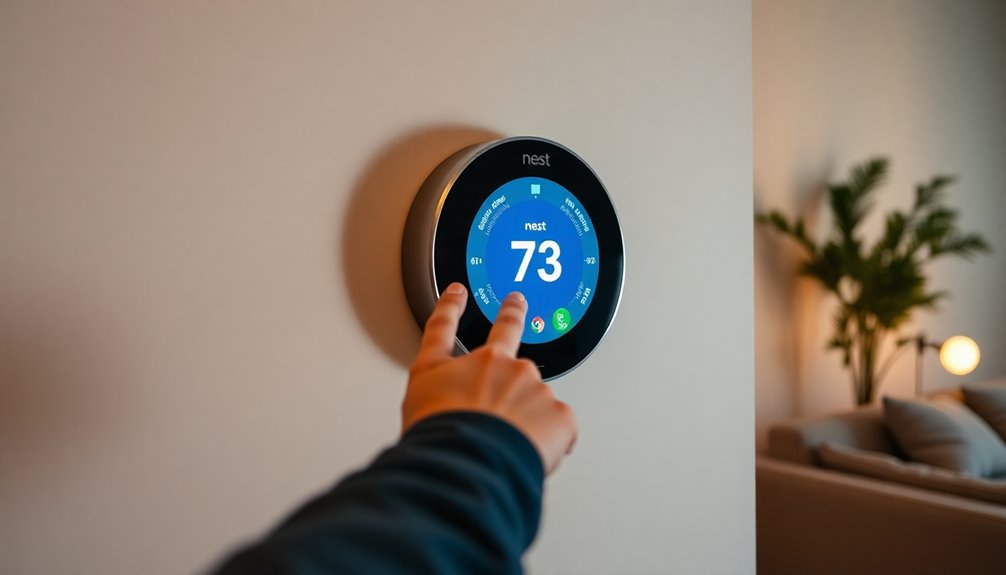
As you look to enhance your home's accessibility, the Nest Thermostat stands out with its intuitive design and features. This digital design solution prioritizes usability for all users, particularly those with specific needs.
Here's what makes it a game-changer:
- Large Displays: Easy-to-read screens aid individuals with visual impairments.
- Voice Control: Compatible with Google Assistant and Amazon Alexa, it allows hands-free adjustments for those with mobility challenges.
- Learning Capability: The thermostat learns your schedule, optimizing comfort without complex manual settings.
- Remote Access: Control your home's temperature from anywhere via smartphone apps, ensuring convenience.
With its eco-friendly approach, the Nest Thermostat not only enhances accessibility but also promotes a sustainable living environment.
Hand Dryers
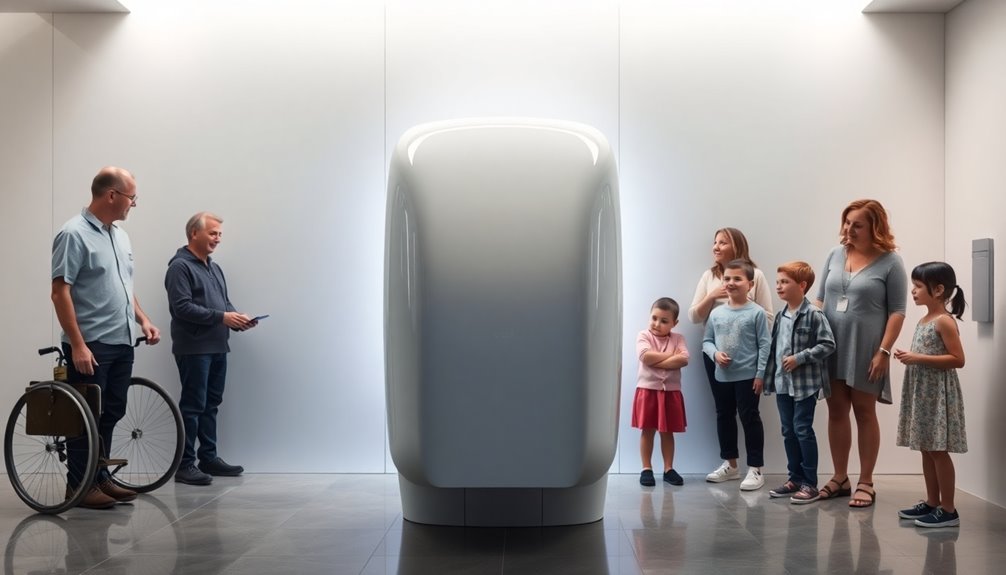
In addition to smart home devices like the Nest Thermostat, accessible innovations in public spaces, such as hand dryers, play a significant role in enhancing usability for everyone. These modern hand dryers often feature sensor technology for touchless operation, catering to diverse accessibility needs and promoting hygiene. Ergonomic considerations are key; some designs guarantee ease of use for individuals with limited hand strength, fostering inclusivity. These advancements in public amenities reflect the growing trend towards universal design principles that prioritize accessibility for all.
| Feature | Benefits |
|---|---|
| Touchless Operation | Minimizes contact, enhancing hygiene |
| Adjustable Settings | Caters to user preferences |
| High-Speed Drying | Reduces wait time in busy areas |
These innovations reflect universal design principles, making public restrooms more accessible for all users.
Acoustic Panels
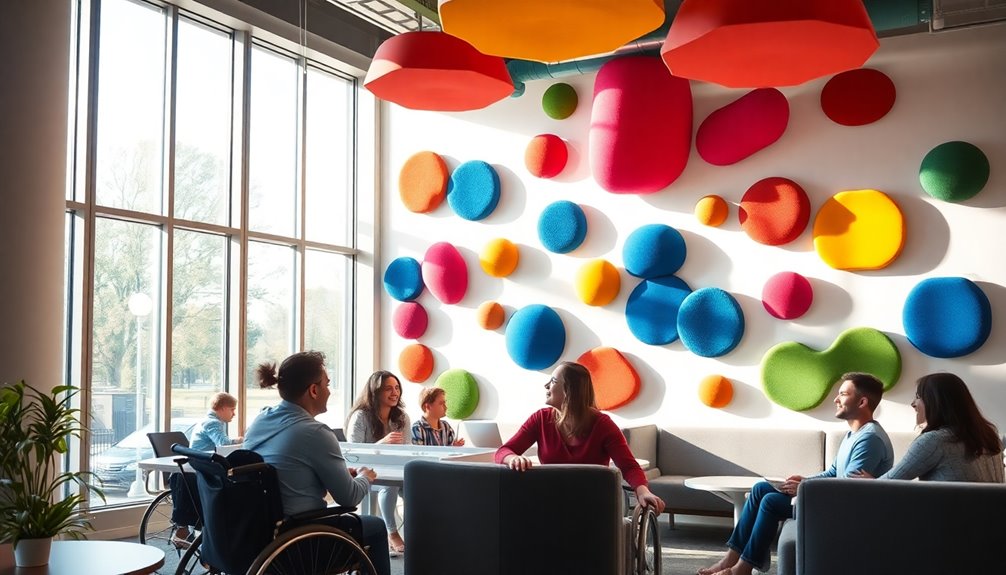
Acoustic panels transform noisy environments into serene spaces, making them essential in places like offices and classrooms. By absorbing sound, these panels enhance auditory comfort for everyone, especially those with hearing sensitivities.
Here's why you should consider integrating acoustic panels into your design process:
- Diverse Styles: Available in various colors and textures for seamless integration into your aesthetic.
- Sustainability: Many panels use eco-friendly materials, promoting a greener environment.
- Focus Improvement: Reducing distractions helps community members, especially neurodiverse individuals, concentrate better.
- Enhanced Communication: Improved acoustics facilitate clearer discussions and understanding, making learning materials more effective.
Additionally, incorporating essential oils into your space can further promote relaxation and enhance the overall atmosphere.
Incorporating acoustic panels can greatly elevate the productivity and comfort of your spaces!
Shower Benches
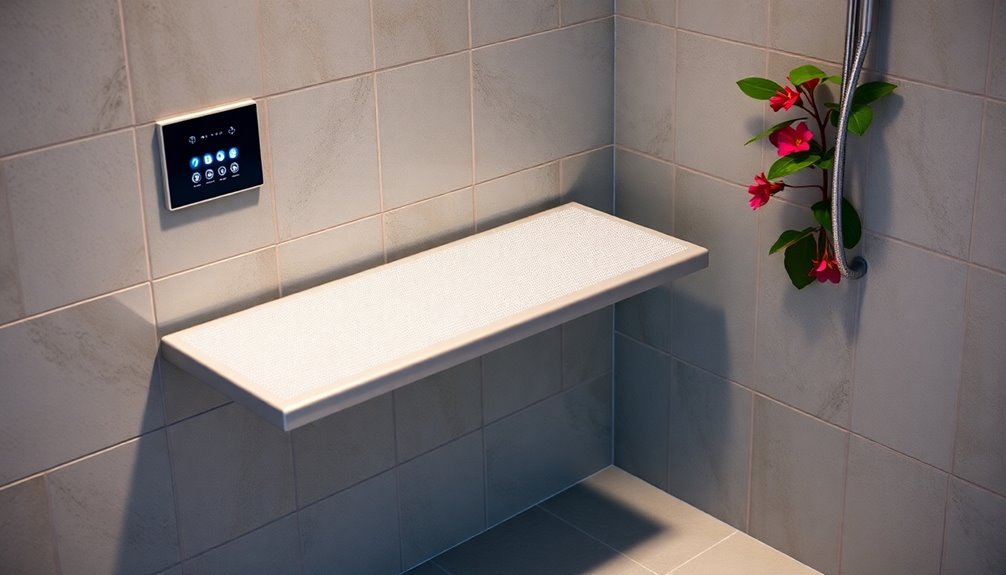
When designing a bathroom, incorporating shower benches can greatly enhance safety and accessibility for all users. These benches provide a stable seating option for individuals with limited mobility, allowing them to bathe with confidence.
QuickDrain's BenchSeat meets ADA standards, ensuring it offers proper height and weight support for users. Shower benches can also double as storage, relaxation spots, or aids for personal hygiene tasks.
Opting for a curbless shower design with a shower bench promotes seamless access for wheelchair users and those with mobility aids. Plus, many eco-friendly models use up to 400 recycled water bottles, blending sustainability into universal design.
Incorporating proper height and weight support in the design of shower benches ensures functionality and safety for all users. Embracing these innovations makes your bathroom a more inclusive space for everyone.
Frequently Asked Questions
What Is Universal Design for Accessibility?
Universal design for accessibility means creating spaces and products that everyone can use, regardless of their abilities.
It's about making things intuitive and flexible, so you don't have to adapt or struggle.
When you implement universal design principles, like simplicity and tolerance for error, you enhance usability for everyone.
This approach not only improves access for those with disabilities but also enriches the experience for all users, fostering inclusivity and social equity.
What Is an Example of a Universal Design in Everyday Life?
One great example of universal design in everyday life is curb cuts.
You'll find these smooth changes at intersections, making it easier for everyone—whether you're in a wheelchair, pushing a stroller, or just walking.
They guarantee safer passage across streets and walkways.
What Are the 7 Principles of Universal Design?
Did you know that nearly 20% of the population experiences some form of disability?
Understanding the seven principles of universal design can help you create more inclusive spaces and products.
These principles include Equitable Use, Flexibility in Use, Simple and Intuitive Use, Perceptible Information, Tolerance for Error, Low Physical Effort, and Size and Space for Approach and Use.
What Is the Difference Between UDL and Accessibility?
The difference between UDL and accessibility lies in their approaches.
UDL focuses on designing learning experiences that cater to all students from the start, promoting flexibility and engagement for diverse learners.
In contrast, accessibility addresses specific needs, often reacting to barriers faced by individuals with disabilities after they arise.
While both aim to enhance participation, UDL fosters a broader inclusive philosophy, whereas accessibility guarantees compliance with legal standards for those with disabilities.
Conclusion
As you explore these game-changing innovations, imagine the world transforming around you—each feature not just enhancing accessibility, but enriching lives. Picture a future where everyone, regardless of ability, moves freely and confidently. But what if this vision isn't just a dream? What if it's within our grasp today? The real question is: will you be part of this movement, or will you let the opportunity slip away? The choice is yours, and the time to act is now.
